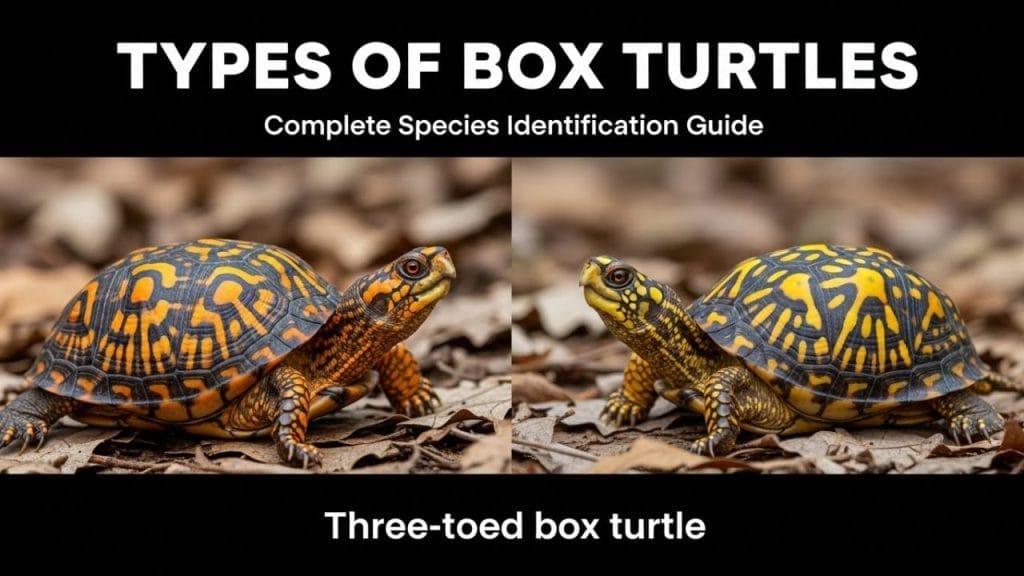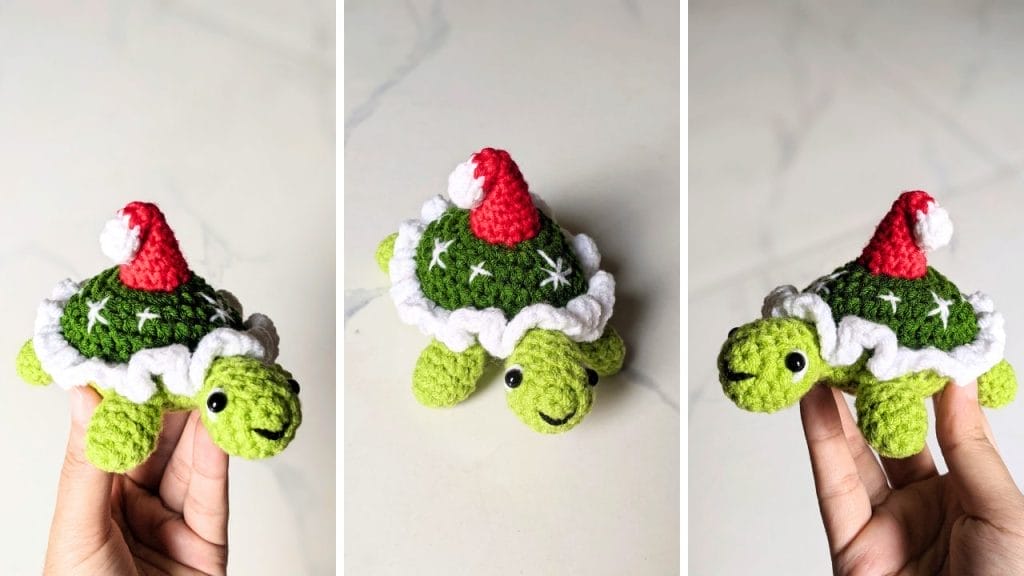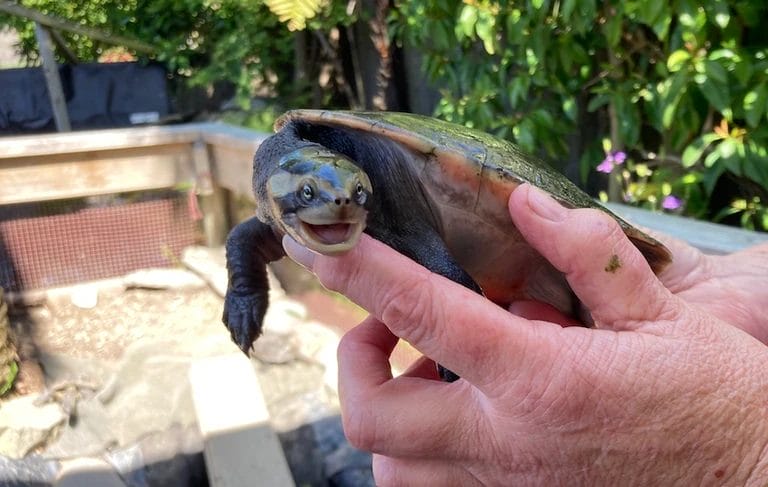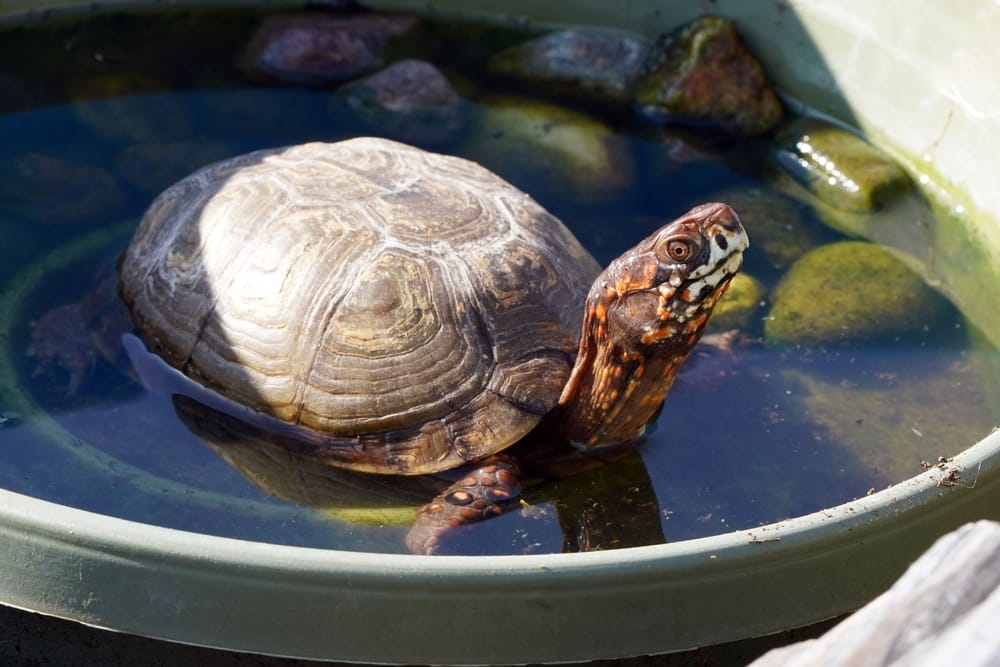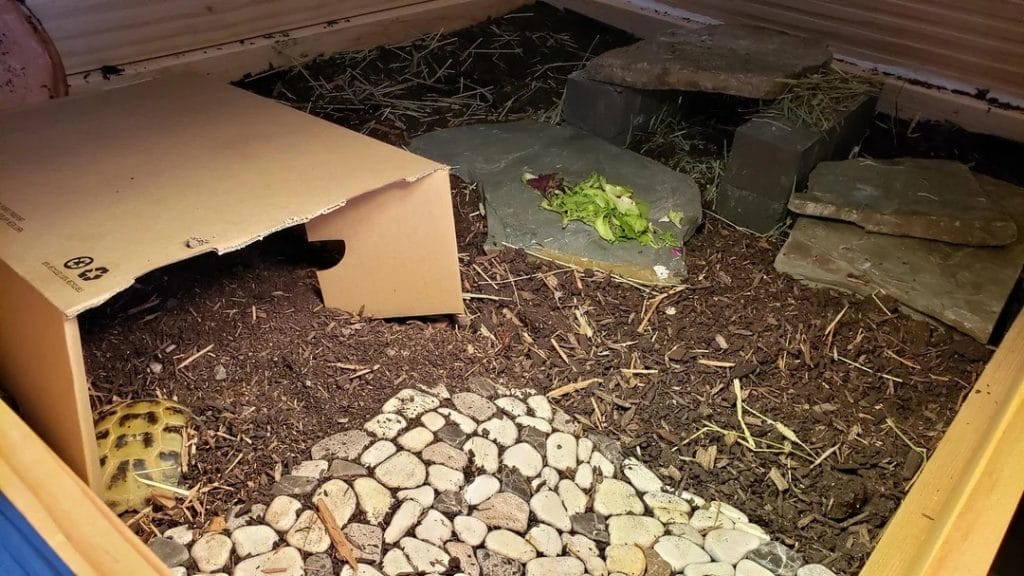How To Take Care Of Box Turtles? [The Ultimate 2025 Guide]

This post was created with help from AI tools and carefully reviewed by a human (Muntaseer Rahman). For more on how we use AI on this site, check out our Editorial Policy.
So you want a box turtle? Or maybe you already have one and just realized that 40-gallon tank you bought isn’t cutting it.
Look, I get it. Box turtles are adorable with their little hinged shells and those curious eyes. But here’s the truth bomb: most pet box turtles die way earlier than they should because their owners had no clue what they were getting into.
We’re talking about a creature that can live 50-100+ years in the wild but barely makes it to 10 in captivity. That’s not cute. That’s tragic.
But you’re here, which means you’re doing better than most. Let’s fix this.
The Reality Check You Need First
Box turtles aren’t starter pets.
They’re not low-maintenance. They’re not good for kids who’ll lose interest in six months. And they sure as hell aren’t decoration for your coffee table.
These guys are sensitive, easily stressed, and will absolutely die if you mess up their care. No pressure though.
Here’s what you’re actually signing up for:
- 30-50+ year commitment (yes, they’ll probably outlive your current relationship)
- Daily maintenance and feeding schedules
- Expensive setup costs (we’re talking $300-500 minimum)
- Possible legal headaches (more on that nightmare later)
- A pet that might never actually like being held
Still here? Good. Let’s do this right.
If this level of commitment sounds overwhelming, semi-aquatic species like painted turtles or red-eared sliders may be more appropriate starting points.
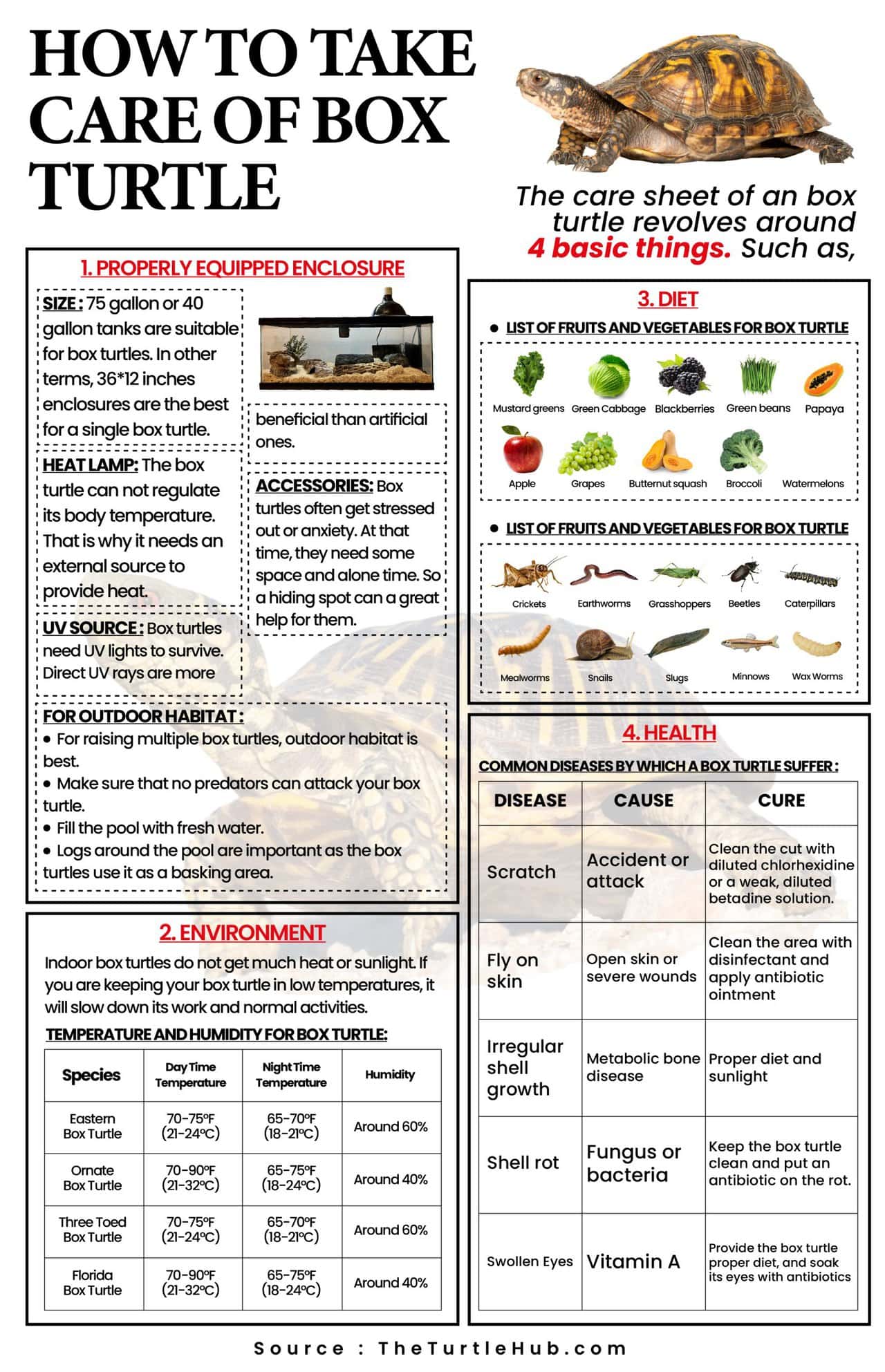
Before You Even Think About Getting One
The Legal Minefield
Here’s something pet stores conveniently forget to mention: box turtles are protected in many states.
In some places, owning one is straight-up illegal without permits. In others, you can only have captive-bred turtles with proper documentation. And taking one from the wild? That’s a federal offense in most states with fines up to $5,000 per turtle.
Check your local laws BEFORE you fall in love with a turtle. States like New York, New Jersey, and Florida have strict regulations. Some states limit you to just one box turtle.
The Size Shock
Pop quiz: what’s the minimum enclosure size experts recommend in 2025?
If you said “40-gallon tank,” congratulations, you’ve been reading outdated guides from 2010.
The actual minimum is 4 feet by 4 feet for outdoor enclosures, or 5.5 feet by 3 feet for indoor setups. That’s about 14 square feet of floor space.
And before you think “minimum is fine,” remember: that’s like living in a closet your entire life. Bigger is always better.
This Hilarious Turtle Book Might Know Your Pet Better Than You Do
Let’s be real—most turtle care guides feel like reading a textbook written by a sleep-deprived zookeeper.
This one’s not that.
Told from the snarky point of view of a grumpy, judgmental turtle, 21 Turtle Truths You’ll Never Read in a Care Guide is packed with sarcasm, sass, and surprisingly useful insights.
And hey—you don’t have to commit to the whole thing just yet.
Grab 2 free truths from the ebook and get a taste of what your turtle really thinks about your setup, your food choices, and that weird plastic palm tree.
It’s funny, it’s honest, and if you’ve ever owned a turtle who glares at you like you’re the problem—you’ll feel seen.
Setting Up The Perfect Habitat
Outdoor vs Indoor: The Great Debate
Outdoor enclosures win, hands down.
Your turtle gets natural sunlight, proper temperature gradients, and actual space to explore. It’s like the difference between living in a studio apartment and having an actual yard.
But outdoor only works if:
- Your climate matches your turtle species (Eastern box turtles need different temps than Ornates)
- You can predator-proof the enclosure (raccoons will absolutely eat your turtle)
- You don’t use pesticides anywhere nearby
If you’re going indoor, accept that you’re playing god with temperature and lighting. It’s doable, but it’s way more work.
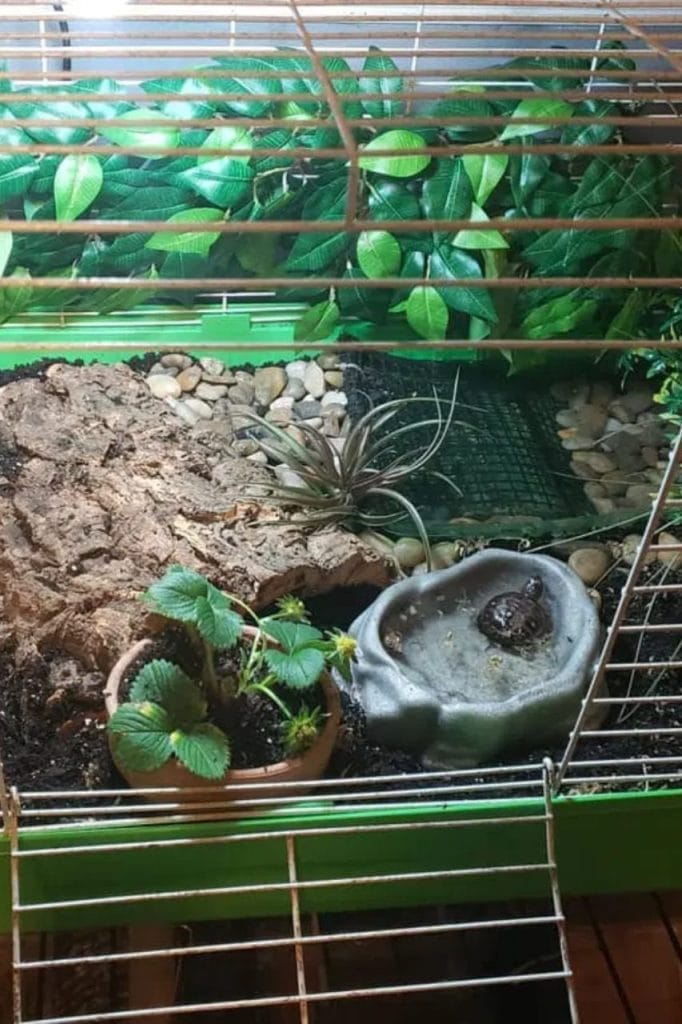
Indoor Enclosure Setup
Forget glass tanks unless you want your turtle to spend its entire life trying to walk through invisible walls. Seriously, they don’t understand glass and will stress themselves to death trying to pass through it.
Better options:
- Large plastic storage bins (opaque sides)
- Custom wooden enclosures (waterproofed)
- “Turtle tables” (basically fancy wooden boxes)
Critical specs:
- Minimum 5.5′ x 3′ for adults (14 sq ft floor space)
- Walls at least 18 inches tall (these guys are escape artists)
- No see-through walls on the bottom half
- Deep enough for 4-6 inches of substrate
The Substrate Situation
This is where people mess up constantly.
Box turtles need to burrow. It’s not optional, it’s hardwired into their DNA. Shallow substrate = stressed turtle = dead turtle.
Use a mix of:
- Topsoil (chemical-free, no fertilizers)
- Coconut fiber (holds moisture great)
- Sphagnum moss (helps with humidity)
- Leaf litter on top (makes them feel at home)
Depth: 4-6 inches minimum. Yes, your turtle will disappear completely sometimes. That’s normal.
Never use:
- Cedar or pine shavings (toxic oils)
- Sand alone (dehydration city)
- Gravel or small rocks (impaction risk)
- Anything with chemicals or fertilizers
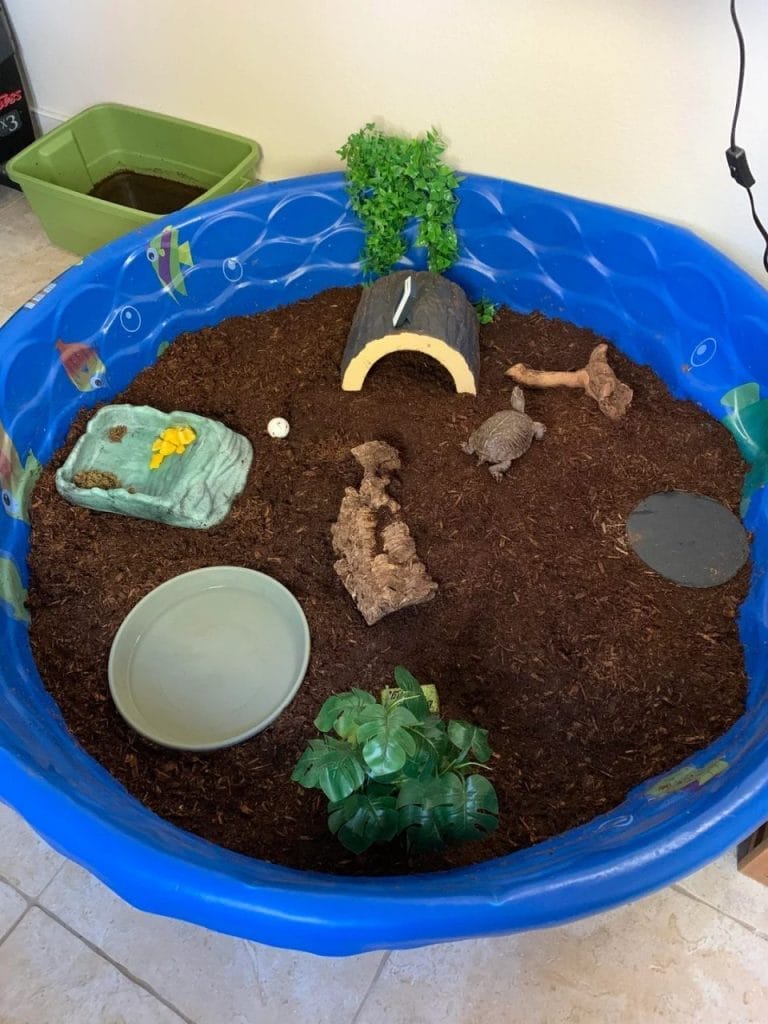
Temperature: Playing With Fire (Sort Of)
Box turtles can’t regulate their own body temperature. You’re literally their thermostat.
Mess this up and they either cook or freeze.
| Species | Daytime | Basking Spot | Nighttime | Humidity |
|---|---|---|---|---|
| Eastern Box Turtle | 70-75°F | 85-88°F | 65-70°F | 60-80% |
| Three-Toed Box Turtle | 70-75°F | 85-88°F | 65-70°F | 60-80% |
| Ornate Box Turtle | 70-90°F | 85-88°F | 65-75°F | 40-60% |
| Florida Box Turtle | 70-90°F | 85-88°F | 65-75°F | 60-80% |
Set up a temperature gradient – warm end to cool end. Let your turtle choose where it wants to be.
Use halogen flood bulbs for basking heat, not those ceramic heat emitters. Turtles need actual light to know it’s daytime.
Get two digital thermometers – one for each end. Those stick-on strips are garbage.
Lighting: The Sun Replacement Kit
Natural sunlight is free and perfect. But since most of us can’t keep our turtles outside year-round, we need to fake it.
You need TWO types of light:
UVB lighting – Not negotiable. Without it, your turtle can’t process calcium and will develop metabolic bone disease.
MBD affects all turtle species kept without proper UVB—our pet turtle myths article debunks the dangerous myth that turtles can survive on artificial light alone.
- Use Arcadia or Zoo Med T5 HO 5.0 or 6% bulbs
- Position 13-18 inches above the basking spot
- Replace every 12 months (even if they still glow)
- Run for 12-14 hours in summer, 10-12 in winter
Bright white light – UVB alone isn’t bright enough.
- Add a 6500K LED or fluorescent
- Should span 75-100% of the enclosure
- Makes your turtle actually feel like it’s daytime
Pro tip: Use a timer. Your turtle needs a day/night cycle, and you’ll forget to turn lights on and off at consistent times.
Humidity: The Moisture Balancing Act
Box turtles are not desert animals. They need moisture.
How to maintain proper humidity:
- Mist the enclosure daily (morning and evening)
- Mix water directly into substrate
- Add a humid hide (container filled with damp sphagnum moss)
- Use a digital hygrometer to monitor (not those analog dial things)
If your turtle’s eyes look sunken or its skin is wrinkly, it’s dehydrated. Fix your humidity immediately.
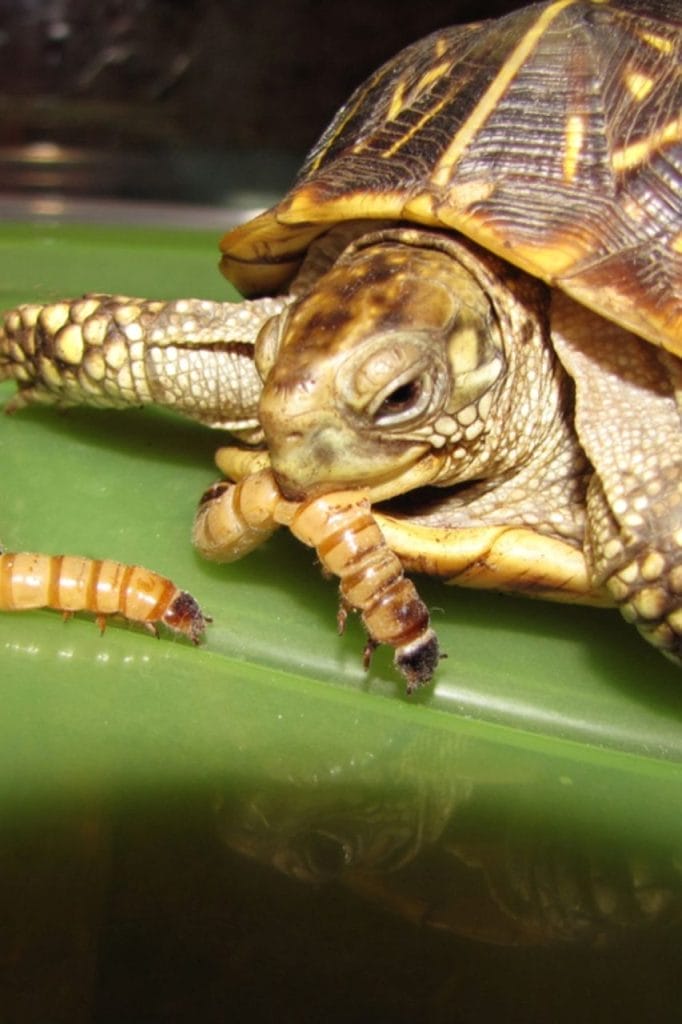
Water: The Soaking Spot
Box turtles need a water dish they can fully climb into and soak.
Requirements:
- Shallow enough to stand in (water to chin level)
- Easy to climb in and out of (add a ramp or rocks)
- Large enough for the whole turtle
- Changed daily (they poop in it, guaranteed)
They’ll drink, soak, and yes, use it as a toilet. Just accept it.
Hide Spots and Enrichment
A stressed box turtle is a dead box turtle.
They need places to feel safe and things to do.
Minimum requirements:
- At least two hide spots (warm end and cool end)
- Natural branches to climb on
- Flat rocks (helps file down their beak and nails naturally)
- Live or fake plants
- Things to explore and destroy
Change up the decor every few months. It keeps their brains active.
Diet: What Your Turtle Actually Needs To Eat
The number one cause of health problems in captive box turtles? Terrible diet.
People feed them the same three things every day and wonder why their turtle is sick. It’s like eating only pizza and expecting to be healthy.
The Age Factor
Baby box turtles (under 1 year):
- Need 70% protein, 30% plants
- Fed daily
- Growing fast, need that protein
Juveniles (1-5 years):
- Shift to 60% protein, 40% plants
- Fed daily or every other day
- Still growing but slowing down
Adults (5+ years):
- Need 50% protein, 50% plants (Eastern and Three-toed)
- Or 60% protein, 40% plants (Ornates are more carnivorous)
- Fed every 2-3 days
- Can easily become obese, watch portions
The Protein Menu
Best options (live is best, frozen works):
- Earthworms
- Night crawlers
- Crickets (gut-loaded)
- Dubia roaches
- Black soldier fly larvae
- Superworms (occasionally)
- Mealworms (occasionally, high in fat)
- Snails and slugs
- Grasshoppers
Occasional treats:
- Cooked chicken (no seasoning)
- Hard-boiled eggs with shell
- Low-fat wet cat food
- Pinky mice (rarely, high fat)
Dust protein with calcium powder 2-3 times per week. This is critical.
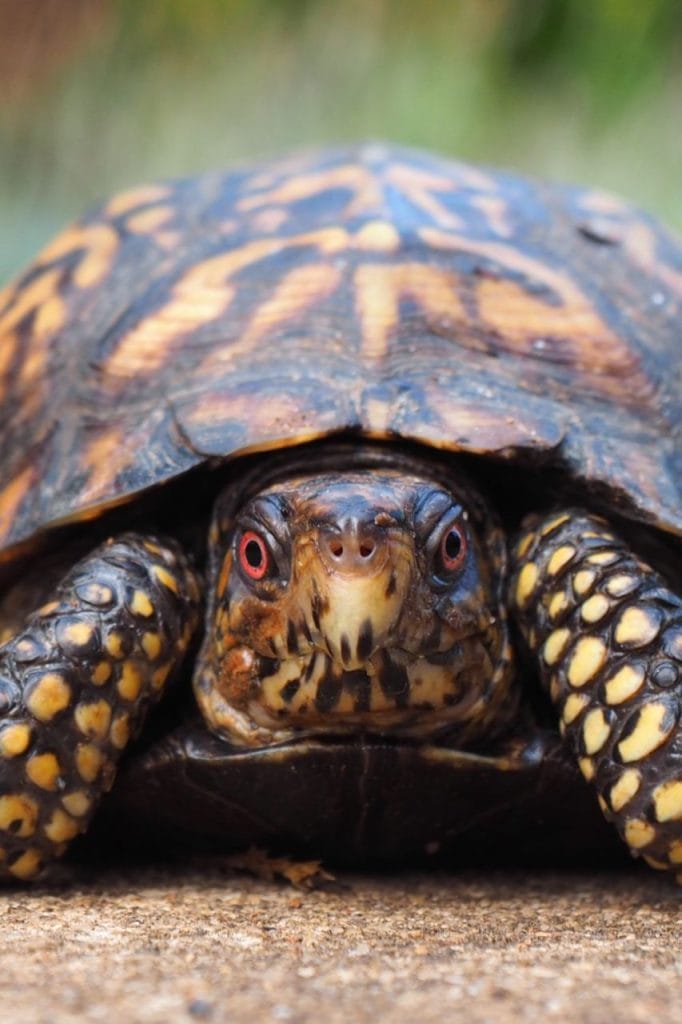
The Plant Menu
Leafy greens (the foundation, 60-70% of plant matter):
- Collard greens
- Mustard greens
- Turnip greens
- Dandelion greens
- Endive
- Escarole
- Romaine lettuce (not iceberg, that’s just water)
Other vegetables (20-30% of plant matter):
- Squash (butternut, acorn, yellow)
- Bell peppers (red, orange, yellow)
- Carrots (shredded)
- Green beans
- Peas
- Sweet potato (cooked)
Fruits (10% max, they’re candy):
- Strawberries
- Blueberries
- Raspberries
- Blackberries
- Mango
- Papaya
- Melon
- Figs (high in calcium, great choice)
Foods to avoid or limit:
- Spinach (oxalates bind calcium)
- Kale (goitrogens affect thyroid)
- Cabbage (goitrogens)
- Iceberg lettuce (nutritionally worthless)
- Avocado (toxic)
- Rhubarb leaves (toxic)
Feeding Schedule and Portions
The head-sized bowl method: Fill a container the size of your turtle’s shell with food. That’s one meal.
The 15-minute method: Put out more food than they can eat, but remove it after 15 minutes.
Pro tips:
- Feed in the morning after they’ve warmed up
- Chop everything into bite-sized pieces
- Mix everything together (prevents picky eating)
- Remove uneaten food within a few hours
- Vary the menu – different foods every day
Supplements: The Insurance Policy
Even with a perfect diet, captive turtles need supplements.
Calcium powder (phosphorus-free):
- Dust food 2-3 times per week for adults
- Every day for growing juveniles
- Critical for shell and bone health
Reptile multivitamin:
- Once per week
- Don’t overdo it (vitamin toxicity is real)
Cuttlebone:
- Leave one in the enclosure
- They’ll nibble as needed
Water and Hydration
Fresh water available 24/7. Change it daily.
Weekly soaks in shallow lukewarm water (15-20 minutes) help with hydration and encourage pooping.
If your turtle isn’t eating, try soaking it first. Dehydrated turtles won’t eat.

Health: What Can Go Wrong
Box turtles hide illness until they’re practically dead. By the time you notice symptoms, it’s often serious.
Signs of a Healthy Box Turtle
- Alert and responsive
- Clear, bright eyes
- Smooth shell (no soft spots, cracks, or unusual growth)
- Breathing quietly (no wheezing or clicking)
- Active during the day
- Regular appetite
- Normal pooping (not too dry, not too runny)
Common Health Problems
Respiratory infections (wheezing, bubbles from nose, lethargy)
- Usually from temps too cold or wrong humidity
- Needs antibiotics from a vet
- Can kill if untreated
Metabolic bone disease (soft shell, swollen jaw, weakness)
- From lack of UVB or calcium
- Often irreversible if caught late
- Prevention is everything
Shell rot (soft spots, discoloration, smell)
- From bacteria or fungus
- Needs antifungal/antibiotic treatment
- Keep wounds dry during treatment
Vitamin A deficiency (swollen eyes, ear abscesses)
- From poor diet
- Needs vitamin A shots and diet improvement
- Very common in captive turtles
Dehydration (sunken eyes, wrinkled skin, lethargy)
- From low humidity or no water access
- Can escalate quickly
- Increase humidity and offer soaks
Parasites (weight loss, poor appetite, runny poop)
- Wild-caught turtles often have them
- Needs fecal exam and deworming medication
- Regular vet checkups catch these
When To See a Vet
Immediately:
- Not eating for more than a week
- Breathing problems
- Shell damage or bleeding
- Swollen or closed eyes
- Lethargy that doesn’t improve
- Dramatic weight loss
Annually:
- Wellness checkups
- Fecal exams
- Shell condition assessment
Find a reptile vet BEFORE you need one. Not all vets know turtles. When your turtle’s sick, it’s too late to start calling around.
Quarantine for New Turtles
Got a new box turtle? Quarantine it for 3 months minimum before introducing it to other turtles.
This prevents disease spread. Many turtles carry parasites or infections that need treatment first.

Handling and Socialization
Box turtles are not dogs. They don’t crave your affection.
The honest truth: Most box turtles tolerate handling at best. Frequent handling stresses them out.
How to handle properly:
- Support their entire body with both hands
- Never pull on limbs, head, or tail
- Keep them low (a fall can crack their shell)
- Limit handling to necessary situations
- Wash hands before and after (salmonella risk)
They might get comfortable with you eventually. Some turtles learn to recognize their keeper and get excited at feeding time. But don’t expect a cuddly pet.
Hibernation: The Dangerous Season
In the wild, box turtles hibernate through winter. Some captive turtles will try to hibernate even indoors.
Hibernation is risky. Many things can go wrong.
If your turtle hibernates outdoors:
- Must be completely healthy first (vet check required)
- Needs to bulk up on food beforehand
- Substrate must be deep enough to prevent freezing
- Monitor weight monthly during hibernation
- Wake them if they’re losing too much weight
If keeping indoors through winter:
- Maintain normal temperatures year-round
- Keep lights on normal schedule
- Some turtles may eat less – that’s fine
- Don’t force hibernation
Never hibernate sick, injured, or underweight turtles. It’ll kill them.
Species-Specific Notes
Eastern Box Turtle
- Most common in pet trade
- Need higher humidity (60-80%)
- More omnivorous as adults
- Can handle cooler temps
- Often have red eyes (males)
Three-Toed Box Turtle
- Named for three toes on hind feet (usually)
- Similar care to Easterns
- Adapt well to captivity
- Need high humidity
- Generally calmer temperament
Ornate Box Turtle
- More prairie/grassland species
- Need lower humidity (40-60%)
- More carnivorous throughout life
- Not recommended for beginners (very sensitive)
- Prefer warmer temps
Florida Box Turtle
- Subspecies of Eastern
- Similar care requirements
- Higher humidity preference
- Often more aquatic than other subspecies
Cost Breakdown: What You’re Actually Spending
Let’s talk money because nobody does.
Initial setup: $300-800
- Enclosure: $100-300
- UVB fixture and bulb: $80-120
- Heat lamp and bulb: $30-60
- Substrate: $30-50
- Water dish, hides, decor: $50-100
- Thermometers and hygrometer: $30-50
- The turtle itself: $100-300 (captive-bred)
Monthly costs: $40-80
- Food (variety is expensive): $30-60
- Substrate replacement: $10-20
- Electricity: varies
Annual costs: $100-300
- UVB bulb replacement: $30-50
- Vet checkup: $50-150
- Supplements: $20-40
- Emergency fund: always have $500+ saved

The Mistakes That Kill Box Turtles
Let’s be real about what actually kills most pet box turtles:
- Too small enclosure. They pace the glass until they’re stressed to death.
- Wrong temperature. Too cold = respiratory infection = death. Too hot = organ failure.
- No UVB lighting. Slow death from metabolic bone disease.
- Poor diet. Usually just feeding them lettuce and one type of bug.
- Low humidity. Dehydration, respiratory problems, kidney failure.
- Clear glass tanks. They don’t understand glass. Constant stress.
- Taking wild turtles. They spend their life trying to go home and die trying.
- Impulse buying. People don’t research first, turtle dies within a year.
- Skipping vet care. By the time symptoms show, it’s often too late.
Should You Actually Get a Box Turtle?
Real talk time.
Don’t get a box turtle if:
- You’re not prepared for 50+ years of commitment
- Your kids are under 12 and will lose interest
- You live somewhere with strict laws against them
- You can’t afford the setup and ongoing costs
- You want a pet that likes being held
- You’re not willing to provide proper space
- You think “eh, close enough” with their care requirements
Do consider a box turtle if:
- You’re genuinely interested in reptile behavior
- You have space for a proper enclosure
- You’re financially stable with an emergency fund
- You’re patient and detail-oriented
- You want a long-term pet project
- You’ve done your research (you’re here, so good start)
- You’re willing to find a reptile vet before problems happen
Legal and Ethical Considerations
Never take a box turtle from the wild. Ever.
Wild populations are declining due to habitat loss, road mortality, and collection for the pet trade. Taking one from the wild could be removing a breeding adult from a struggling population.
Only buy captive-bred turtles from reputable breeders. Ask for:
- Proof of captive breeding
- Health records
- Information about the parents
Check your local laws. Some states require permits. Some ban certain species entirely. Getting caught with an illegal turtle means confiscation and fines.
Don’t release captive turtles into the wild. They’ll die. They don’t know the area, they may carry diseases, or they might be a non-native species.
Final Thoughts: The Commitment Is Real
Box turtles are not impulse pets.
They’re not easy. They’re not low-maintenance. They’re definitely not for everyone.
But if you’re willing to put in the work – the real work, not half-assed attempts – they can thrive under your care for decades.
You’ll watch this animal grow, develop a personality, and recognize you at feeding time. You’ll learn its preferences, its quirks, and its moods.
That’s pretty special. Especially when you remember this turtle might still be with you when you’re retired.
Just don’t screw it up. They deserve better than the typical captive box turtle life expectancy of 5-10 years when they should live 50+.
Do the research. Set up the habitat properly. Feed them right. Get regular vet care. Give them space.
And maybe – just maybe – your turtle will still be around to judge your life choices for the next half-century.
That’s the deal. Take it or leave it.

About Author
Muntaseer Rahman started keeping pet turtles back in 2013. He also owns the largest Turtle & Tortoise Facebook community in Bangladesh. These days he is mostly active on Facebook.


